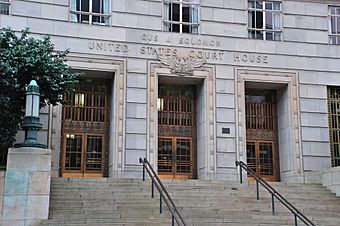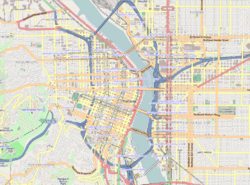Gus J. Solomon United States Courthouse facts for kids
Quick facts for kids |
|
|
U.S. Courthouse
|
|

The building's main entrance, on Main Street
|
|
| Location | 620 SW Main Street Portland, Oregon |
|---|---|
| Area | 117,000 square feet (10,870 m2) |
| Built | 1932–1933 |
| Architect | Morris H. Whitehouse |
| Architectural style | Renaissance Revival |
| NRHP reference No. | 79002142 |
| Added to NRHP | April 30, 1979 |
The Gus J. Solomon United States Courthouse is a historic federal building in downtown Portland, Oregon. It was finished in 1933. This courthouse used to be home to the main federal court for Oregon. That court later moved to a newer building in 1997.
Today, the Solomon Courthouse is used for different things, including offices and a U.S. Postal Service branch. It is a very important building. In 1979, it was added to the National Register of Historic Places, which means it's recognized as a special historic site.
Contents
Building a Landmark: The Courthouse Story
The idea for this federal courthouse came about between 1929 and 1931. A Portland architect named Morris H. Whitehouse designed it. Construction started in 1932. The building was made with a strong steel frame and reinforced concrete.
It cost about $1.5 million to build. That was a lot of money back then! The building was finished very quickly, in just over a year. It opened in September 1933. It has seven floors and eight courtrooms. The building covers about 117,000 square feet.
Cool Design: Architecture of the Courthouse
The outside of the Solomon Courthouse looks like the Renaissance Revival style. This means it has a classic, grand look. You can see tall, flat columns called Doric pilasters on the outside. There are also decorative patterns like triglyphs and metopes (which are carved blocks) along the top.
The inside of the building has a different style called Art Deco. This style was popular in the 1920s and 1930s. It uses bold shapes and rich colors. The building has an open courtyard in the middle. Only the first floor covers the whole city block.
The courthouse uses beautiful materials. The outside is made of light gray sandstone. Inside, you'll find fancy marble, plaster, and oak wood. There are different kinds of marble, like Pink Kasota Fleuri and Red Nebo Golden Travis.
You can also see cool art inside. There's a sculpture honoring Oregon soldiers from World War I. There's also a large marble eagle and a white marble sculpture called Ventana al Pacifico. This sculpture was made by Manuel Neri in 1989.
The courtrooms on the sixth floor are especially grand. They have marble details and leather-covered doors. You'll see oak wood, fancy ceilings, and tall windows. There are also bronze lamps and Corinthian columns, which are another classic design.
What the Courthouse is Used For
When the building first opened, it was home to two important courts. These were the United States District Court for the District of Oregon and the United States Court of Appeals for the Ninth Circuit. The Court of Appeals moved out in 1973. The District Court moved to the new Hatfield Federal Courthouse in 1997.
In 1988, the courthouse was renamed. It was named after Judge Gus J. Solomon. He was a judge who served for a very long time. The building was added to the National Register of Historic Places in 1979.
For many years, there was also a post office on the first floor and in the basement. This post office moved out in 1984. But a postal branch reopened in the courthouse in 2004.
Today, the courthouse is used for many things. New citizens are often sworn in here. It has also been used as a setting for plays and even a Hollywood movie called The Hunted. There are plans for the federal bankruptcy court and the Internal Revenue Service to move into the building after some updates.
Important Moments in Courthouse History
- 1932: Construction begins, and the cornerstone is laid. Inside the cornerstone, they put newspapers and photos.
- 1933: The new federal courtrooms officially open.
- 1979: The U.S. Courthouse is listed on the National Register of Historic Places.
- 1989: The building is renamed the Gus J. Solomon U.S. Courthouse. This honors Judge Gus J. Solomon, who served for 37 years.
Images for kids






